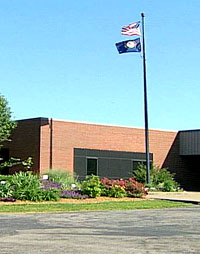University of Kentucky Research And Education Center in Princeton Marks 75th Anniversary
University of Kentucky Research And Education Center in Princeton Marks 75th Anniversary

Seventy-five years ago, through the efforts of the people of Caldwell County, what would become the University of Kentucky Research and Education Center was formed in Princeton.
Its beginnings came from a desire by residents of western Kentucky to have an agriculture experiment sub-station. The community raised the money needed to buy 400 acres of land and deeded it to the state.
At the dedication in 1925, an estimated 8,000 to 12,000 people attended including hundreds of schoolchildren. Schools in the community played a vital role in raising the money to buy the land for the center.
Princeton resident Miles Ladd, 89, remembers attending a fund-raising rally and the barbecue that was served when he was a student at Battle Creek.
"All the schools around came," he said. "And a few of us went in wagons."
The farming then was done with mules and horses, he said. Nothing like the horsepower used on farms today.
In the early days, researchers from Lexington conducted research. But over the decades staff was added at the Princeton facility. Today, it has 30 research and extension specialists at the center, and employs a total of 65 workers.
The center has also grown to nearly 1,300 acres.
On July 2O, the station will hold its biennial field day highlighting the research being conducted by faculty and staff. This year's event also will celebrate the UKREC's anniversary.
Scientists at the center work to improve farming methods by conducting applied research both on the research farm as well as on farms throughout western Kentucky. The plots are used to collect research data as well as serving as sites for extension programs.
Research at the center has grown and changed with the needs of the farm community.
Early research conducted at the center was tests and demonstration plots on pastures, soil improvement and tobacco. The center had a dairy herd, and dairy research took place at the center for 41 years, as well as poultry research for about the same time frame. Both ended in the 1960s.
Beef research as been ongoing at the center for decades. It remains a part of the research and extension efforts today as does swine production. Horticulture crops are also a part of the research mixture at the center.
The center's fundamental purposes from the beginning are to discover better methods of farming in western Kentucky and to demonstrate those methods to farmers. That has been done through educational programs and field day activities.
Crop research has included fertilization, crop rotation effects on yield, plant variety development, disease and pest control.
Minimum tillage and no-tillage methods, developed largely at the UK Lexington campus and through research at the Princeton station, made a tremendous impact on agriculture in the 20th century.
Research and demonstrations showed no-till has advantages in yields as well as in protecting soil and water resources.
Studies at Princeton also aided in establishing the University of Kentucky as a leader in double-cropped soybean technology in the South. Soybeans are planted in the early summer behind some 90 percent of the small grains grown in Kentucky fields today. Most of these beans are planted using no-tillage technology developed by UK scientists.
The integrated pest management program was instituted in the 1970s at the substation to help farmers better manage pests in their crops. The IPM program has proved popular with farmers and teaches farmers to use economics as the driving force to improve pest control.
The program's impact has lessened the use of hazardous pesticides and costs associated with pest control have been reduced.
Research on the effects of soil compaction on crops and pasture led scientists, in conjunction with a Russellville, Ky., firm, to develop an affordable penetrometer that can pinpoint soil compaction problems. Today, thousands of the devices are used throughout the United States.
As the center celebrates its first 75 years, research in precision agriculture, biotechnology, new crops, and environmental management will likely be added to the ongoing mix of research and educational programs.